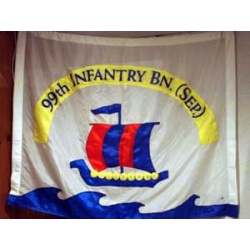
first on decorahnews.com: Surviving members of the 99th Infantry Battalion will be honored by the Norwegian government
Vesterheim Norwegian-American Museum is the official national repository of artifacts from World War II's 99th Infantry Battalion, an elite unit of Norwegian-speaking American soldiers specially trained to fight Nazis in Norway. Now those artifacts will take on additional significance.
decorahnews.com has learned that the Norwegian government is planning a ceremony on May 28th in Washington, D.C. to give the Norwegian World War II medal to the 48 remaining members of the Battalion. The ceremony will take place at the Norwegian Embassy. Organizers of the event tell decorahnews.com that around 15 of the 48 surviving members of the battalion are expected to make it to DC. The medal will be awarded by the Norwegian Chief of Defence, as a part of his official visit to the United States in May. The organizer of the trip, Erik Wiborg says his group is still trying to raise an additional $10,000 to bring these veterans to Washington DC. You can contact Wiborg for information about donations (erikwiborg@yahoo.com).
The 99th infantry Battalion was activated in July of 1942 by the U.S. War Department, which wanted to prepare for the possibility of fighting in Norway. Originally the unique elite unit was to consist only of Norwegians, but the War Department expanded the battalion to include Americans with direct Norwegian descent. Soldiers picked out for this elite unit had to have a working knowledge of the Norwegian language and preferably already knowing how to ski. To this date the 99th Infantry Battalion (Separate) is the only unit of the United States Army with a pure Norwegian history.
Interestingly, when the battalion eventually was sent into combat, it was in France and not in Norway. The 99th Infantry Battalion saw heavy action in France, Belguim and Germany in the last half of 1944 and all of 1945.
100 members of the 99th Infantry Battalion did see action in Norway eventually. They were trained to destroy railroad lines in Norway to make it impossible for the Germans to move the troops stationed in Norway out of the country to the European continent where they would be needed during the final battles of the war. Because the British Navy had mined the Norwegian coastal waters, the railroad was viewed as the only way for the Germans to move their troops south. "Operation RYPE," as it was called, was a success, with the troops parachuting just across the border in Sweden, then operating behind enemy lines to blow up several railroad bridges.
The history of the 99th Infantry Battalion is on display at the Vesterheim Norwegian-American Museum. Members of the Battalion had a reunion several years after the war--and realized they needed a place to preserve momentoes of the unit. They chose Vesterheim because of its association with Norwegian-American history.
Site designed and maintained by Iroc Web Design Services©.
Your Small Business Web Design Solutions.™





